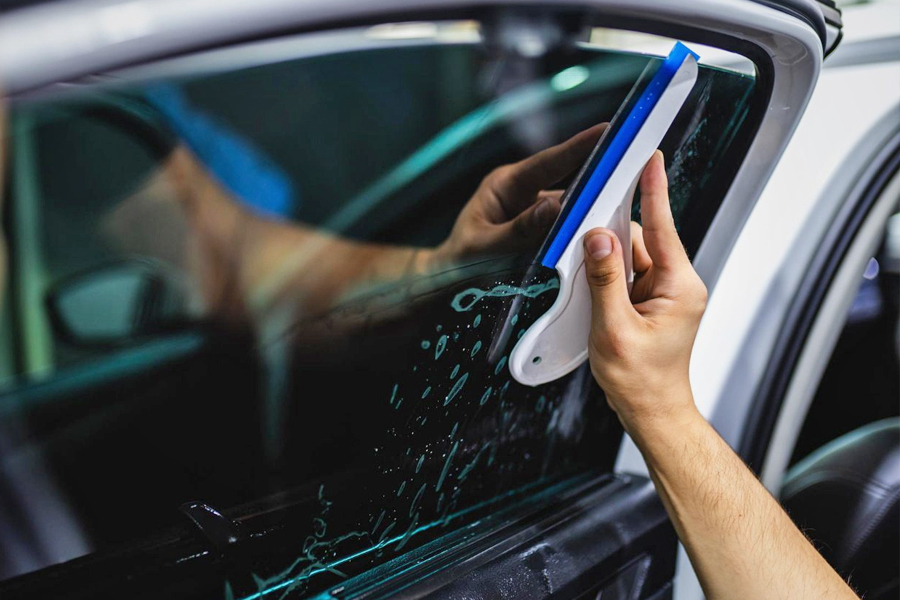Vehicle Window Tinting for Improved Security and Minimized Break-Ins
Vehicle Window Tinting for Improved Security and Minimized Break-Ins
Blog Article
Home Window Tinting Laws and Guidelines: What You Required to Know Before Tinting Your Vehicle
Prior to waging window tinting for your automobile, it is important to acquaint yourself with the varied regulations and standards that regulate this method across various states. These guidelines determine the allowable degrees of tint darkness, commonly gauged by visible light transmission (VLT) percents, and include particular specifications for front windshields focused on ensuring road safety and security. Furthermore, specific jurisdictions might supply clinical exemptions for people with certifying conditions. Recognizing these intricacies can save you from prospective lawful implications, however what are the particular rules in your state?
Introduction of Window Tinting Rules
Window tinting regulations are often subject to variation throughout different territories, mirroring regional laws and safety and security considerations. These legislations dictate the acceptable levels of color darkness and reflectiveness on lorry windows, ensuring that chauffeurs keep ample exposure while also protecting against dangerous UV rays and warmth.
The majority of laws categorize window tinting based upon the Visible Light Transmission (VLT) percentage, which shows the amount of light that can pass via the home window. Generally, lower VLT percentages indicate darker tints. Regulations usually differentiate in between the front, side, and back home windows, with more stringent restrictions put on the front windscreen to enhance safety for both the vehicle driver and other road users.
Additionally, some territories enforce restrictions on the reflectivity of the tint, avoiding excessive glare that could harm visibility. Exceptions to these regulations may exist for people with certain clinical problems needing added sun security. Conformity with home window tinting policies is crucial, as offenses can lead to fines, necessary elimination of the color, and possible boosts in insurance coverage premiums. It is essential for automobile owners to familiarize themselves with neighborhood regulations prior to continuing with home window tinting installments.
State-by-State Color Regulations
Understanding the specific window tinting regulations in each state is important for car owners seeking to follow the legislation. Each state in the united state has established its own set of rules governing window tinting, which can differ substantially. These regulations commonly dictate the allowable degrees of tint darkness, the sorts of home windows that can be tinted, and any type of clinical exceptions that might apply.
As an example, states like The golden state have rigid limitations on tint darkness for front windows, while others, such as New Mexico, may allow darker tints. Furthermore, particular states mandate details presence percents for different windows, consisting of the windshield, front side windows, and rear windows. It is essential for automobile proprietors to acquaint themselves with their state's legislations to prevent prospective penalties or charges.
Moreover, some states might call for a qualification sticker to be positioned on tinted windows, suggesting compliance with state laws. Failing to stick to these guidelines not just runs the risk of legal effects but can also impact security and presence while driving. Consequently, vehicle owners should perform thorough study or speak with neighborhood authorities to ensure complete understanding and compliance with state-by-state color laws.
Allowed Color Degrees and Kinds
Many automobile proprietors might be amazed to discover that allowed tint degrees and kinds differ commonly across various states. Each state has actually established its very own laws relating to the permissible darkness and reflectivity of home window tint, often measured by Visible Light Transmission (VLT) percentages. VLT describes the amount of light that can travel through the tinted windows; thus, a lower percentage indicates a darker tint.

Moreover, the sorts of color materials enabled can differ, with some states banning metallic or mirror-like surfaces. It is essential moved here for automobile proprietors to familiarize themselves with their state's certain laws to guarantee compliance. Non-compliance can result in fines, necessary removal of the color, or other lawful consequences, making it imperative to comprehend these regulations prior to waging installation.
Medical Exemptions for Tinting
While not all states offer allowances for medical exceptions regarding home window tinting, those that do identify the need for specific people to improve exposure and comfort because of clinical conditions. Various medical problems, such as lupus, skin cancer cells, and specific eye problems, can provide individuals particularly sensitive to sunshine. These people may need darker tints to secure themselves from dangerous UV rays and glow.

It is essential to keep in mind that despite a clinical exemption, there might still be constraints on the degree of color enabled. Compliance with state regulations guarantees that people are both safeguarded and within legal limits. Those thinking about medical exemptions should contact their local Division of Electric motor Cars or equivalent authority to recognize the treatments and demands required to make an application for an exception effectively.
Fines for Non-Compliance
Falling short to abide by home window tinting legislations can bring about significant penalties, which differ by state. Police are empowered to release citations for cars that do not comply with the defined tinting guidelines. These penalties typically consist of fines, which can range from small quantities to numerous hundred dollars, relying on the severity of the infraction and the state concerned.
In some territories, duplicated offenses might cause escalating penalties or extra charges, such as mandatory court appearances. Moreover, non-compliance may demand the elimination of illegal tinting, typically at the owner's expense. In severe situations, regular offenders might face suspension of their automobile enrollment until conformity is achieved.
Furthermore, insurance coverage implications may occur from getting numerous citations for window tint infractions. Insurers may watch such violations as an indicator of riskier behavior, potentially bring about increased costs or trouble in coverage.
To prevent these charges, it is click here now critical for car proprietors to acquaint themselves with their local home window tinting legislations and guarantee that their lorry complies (Window Tinting). This aggressive strategy not just prevents lawful implications but likewise promotes road safety
Final Thought

Most laws identify home window tinting based on the Visible Light Transmission (VLT) portion, which shows the amount of light that can pass with the window. Conformity with window tinting policies is vital, as violations can result in fines, mandatory removal of the color, and potential increases in insurance premiums.Recognizing the particular home window tinting regulations in each state is vital for car proprietors looking for to comply with the legislation. These policies commonly determine the allowed degrees of color darkness, the kinds of windows that can be tinted, and any type of medical exemptions that may apply.
For circumstances, states like California have rigid restrictions on tint darkness for front home windows, while others, such as New Mexico, may enable darker tints.
Report this page